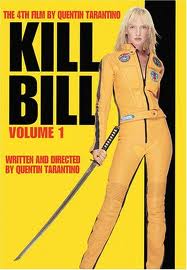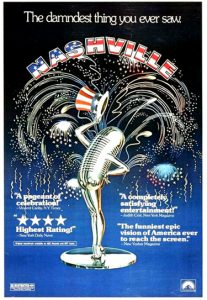Review By Dan Geddes
Uma Thurman …. The Bride (Black Mamba)
David Carradine …. Bill
Lucy Liu …. O-Ren Ishii (Cottonmouth)
Daryl Hannah …. Elle Driver (California Mountain Snake)
Vivica A. Fox …. Vernita Green (Copperhead)
Michael Madsen …. Budd (Sidewinder)
Michael Parks …. Earl McGraw
Written and Directed by Quentin Tarantino.
See also review of Pulp Fiction and Kill Bill 2 and Tarantino satires: Harder and Scent of a Banknote.
Note: This review reveals some of the movie’s secrets, so you might prefer to see the movie before reading the review.
Kill Bill is an all-out assault on the senses.
Movie-goers expect certain things of Tarantino, such as that it will be a violent ride. Kill Bill does not disappoint on these grounds.
It is billed as a tribute to chop-socky films, and it really is the most violent movie you’ve ever seen.
Uma Thurman stars as a ninja assassin, known as The Bride as or Black Mamba, who is wronged by her boss, Bill. Actually, Bill murders her entire wedding party, but Thurman miraculously survives. Kill Bill is the story of her vengeance. In a voice-over she compares her vengeance to the will of God, and the justness of her cause makes it easier to root for her as she begins her killing spree. But first she must snap out of her coma, caused by a bullet to the head.
Kill Bill’s relentless assault is perhaps most intense as Thurman lies comatose in the hospital. Elle (Darryl Hannah), another of Bill’s ninjas, sneaks into the hospital dressed in a nurse’s outfit. She is poised to inject Thurman with poison—and the phone rings. Bill calls Elle to cancel the hit on Thurman.
So she stays comatose for four years until a mosquito (which is filmed as a graphic close-ups) stings her, and she wakes up screaming. From that moment on, the battle for her life begins. She remembers the bullet speeding toward her. She reads her own palms and determines that four years have passed. Soon, a hospital staffer comes down the hall with a friend. Thurman must pretend she is still comatose. Standing over her, the staffer explains to his friend the rules of paying $75 to violate her comatose body. From that moment on, Thurman is in the fight of her life.
The beautiful Uma Thurman makes a sensational centerpiece for the film. The movie opens with Uma in her wedding dress, telling Bill that the baby was his, the second before he shoots her. (You sense he will regret this, but Bill (David Carradine) is only glimpsed in this film.) After she awakes from her coma, four years later, her plan is instinctive: she must systematically kill everyone who pulled the hit job on her family at her wedding. In Kill Bill: Vol. 1. we have no evidence that Uma ever wronged her ninja assassin colleagues.
Tarantino’s story is simple but powerful, and his direction is, well, spotless. Kill Bill pushes the envelope of screen violence. Not only are the numbers of people killed in close range innumerable, mainly during the Tokyo scene, but the tension is sustained continuously, even when murders are not occurring before our eyes. Also, dismemberment is here bloodier than ever, featuring sustained close-ups on the stumps, raining blood as if out of a watering can. Some bodies bleed so long that you know it is Tarantino exaggerating cartoonishly. This technique sometimes breaks the movie’s spell.
Violence is Tarantino’s medium. He has several techniques. He draws out tension before the violence, as his articulate characters engage in hip, ironic dialogue with weapons drawn. The violence itself, which is usually close-up and loud, seems designed to make us squirm. We grin at how smarter these assassins are compared to the crude stereotypes in countless lesser chop-socky movies, not to mention samurai films, gangster films or westerns. Kill Bill is better than most, and also self-consciously positions itself as a tribute to the genre, which allows Tarantino to borrow every convention and to still seem to make an original contribution; and to still be seen as adding something the history of film.
Tarantino understands viewers’ perceptions. Americans’ perception of martial arts movies is that they are “B movies.” Tarantino excels in this critically disparaged genre, bringing star power, as well as high production values and execution.
Miramax made what was billed a controversial decision in releasing Kill Bill in two parts, as it was shot as one movie. At bottom, it a shameless revenue booster, but Kill Bill: Vol. 1 is already enough to see in one sitting. I used the time during the movie’s animated episode to process what I’d already seen. My disquieting thought was: What will be pushing the envelope of violence in ten years?






Be First to Comment